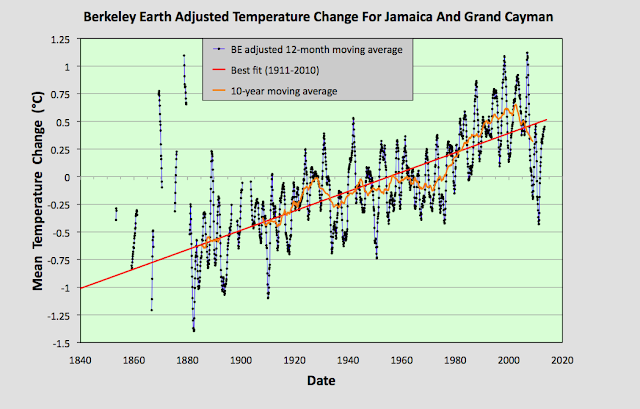To the south of Cuba lie the Cayman Islands and Jamaica. These islands have only five significant stations between them, one on Grand Cayman and the other four in Jamaica. Their locations are shown on the map in Fig. 108.1 below.
Fig. 108.1: The (approximate) locations of the five medium weather station records in Jamaica and Grand Cayman. Those stations with a high warming trend between 1911 and 2010 are marked in red.
All are medium stations with over 480 months of data, but only one has more than 900 months of data (Kingston-Norman Manley). Two stations have virtually no data before 1960 (Grand Cayman and Montego Bay) and two have virtually none after (Kingston and Negril Point Lighthouse). All five stations exhibit warming tends, where a warming trend is defined as one where the temperature gradient for 1911-2010 is positive and exceeds twice the error in that trend. The average of the temperature anomalies from these five stations is shown in Fig. 108.2 below. The mean temperature anomaly (MTA) for the region exhibits two distinct warming trends, a moderate warming of 0.68°C per century before 1980 and a much larger jump after.
Fig. 108.2: The mean temperature change for Jamaica and Grand Cayman relative to the 1941-1980 monthly averages. The best fit is applied to the monthly mean data from 1901 to 1980 and has a positive gradient of +0.68 ± 0.07 °C per century.
The anomalies for each station were determined using the usual method as outlined in Post 47. This involved first calculating the monthly reference temperatures (MRTs) for each station using a set reference period, in this case from 1941 to 1980, and then subtracting the MRTs from the raw temperature data to deliver the anomalies. If a station had at least twelve valid temperatures per month within the MRT interval then its anomalies were included in the MTA calculation. The total number of stations included in the MTA in Fig. 108.2 each month is indicated in Fig. 108.3 below.
Fig. 108.3: The number of station records included each month in the mean temperature anomaly (MTA) trend for Jamaica and Grand Cayman in Fig. 108.2.
Next I calculate the corresponding MTA result based on data that has been adjusted by Berkeley Earth (BE). The result is shown in Fig. 108.4 below and, unlike the raw data in Fig. 108.2, it exhibits a more linear warming trend with temperatures rising by about 1°C since 1910.
Fig. 108.4: Temperature trends for Jamaica and Grand Cayman based on Berkeley Earth adjusted data. The best fit linear trend line (in red) is for the period 1911-2010 and has a gradient of +0.87 ± 0.03°C/century.
Comparing the curves in Fig. 108.4 with the published Berkeley Earth (BE) version for Jamaica only in Fig. 108.5 below indicates remarkably good agreement at least as far back as 1920. This is despite the MTA in Fig. 108.4 including data from Grand Cayman. This would suggest that the simple averaging of anomalies to generate the MTA in Fig. 108.2 is as effective and accurate as the more complex gridding method used by Berkeley Earth. It also means that the averaging process cannot be responsible for the difference in trends between that using unadjusted data in Fig. 108.2 and that using adjusted data in Fig. 108.4.
Fig. 108.5: The temperature trend for Jamaica since 1820 according to Berkeley Earth.
The differences between the MTA in Fig. 108.2 and the BE versions using adjusted data in Fig. 108.4 and Fig. 108.5 are instead mainly due to the data processing procedures used by Berkeley Earth. These include homogenization, gridding, Kriging and most significantly breakpoint adjustments. These lead to changes to the original temperature data, the magnitude of these adjustments being the difference in the MTA values seen in Fig. 108.2 and Fig. 108.4. The magnitudes of these adjustments are shown graphically in Fig. 108.6 below. The blue curve is the difference in MTA values between adjusted (Fig. 108.4) and unadjusted data (Fig. 108.2), while the orange curve is the contribution to those adjustments arising solely from breakpoint adjustments. In this case, unlike most instances in previous posts for the region, the adjustments actually reduce the amount of warming.
Fig. 108.6: The contribution of Berkeley Earth (BE) adjustments to the anomaly data in Fig. 108.4 after smoothing with a 12-month moving average. The blue curve represents the total BE adjustments including those from homogenization. The linear best fit (red line) to these adjustments for the period 1911-1980 has a negative gradient of -0.252 ± 0.015 °C per century. The orange curve shows the contribution just from breakpoint adjustments.
According to the raw unadjusted temperature data, the climate of Jamaica and Grand Cayman has probably warmed by between 1°C and 2°C over the past century with only 0.5°C of warming occurring before 1980 (see Fig. 108.2). However, given that this is based on only five sets of data, and only three at most at any given time, this result contains a high degree of error.
Over the same period adjusted temperature data from Berkeley Earth claims to show that the climate of Jamaica has warmed by almost 1.0°C since 1900 (see Fig. 108.4) and 1.5°C since 1840 (see Fig. 108.5).
Acronyms
BE = Berkeley Earth.
MRT = monthly reference temperature (see Post 47).
MTA = mean temperature anomaly.
List of all stations in Jamaica.
List of all stations in the Cayman Islands.






No comments:
Post a Comment